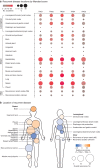Prognostic value of Mandard score and nodal status for recurrence patterns and survival after multimodal treatment of oesophageal adenocarcinoma
- PMID: 38387083
- PMCID: PMC10883709
- DOI: 10.1093/bjs/znae034
Prognostic value of Mandard score and nodal status for recurrence patterns and survival after multimodal treatment of oesophageal adenocarcinoma
Abstract
Background: This study evaluated the association of pathological tumour response (tumour regression grade, TRG) and a novel scoring system, combining both TRG and nodal status (TRG-ypN score; TRG1-ypN0, TRG>1-ypN0, TRG1-ypN+ and TRG>1-ypN+), with recurrence patterns and survival after multimodal treatment of oesophageal adenocarcinoma.
Methods: This Dutch nationwide cohort study included patients treated with neoadjuvant chemoradiotherapy followed by oesophagectomy for distal oesophageal or gastro-oesophageal junctional adenocarcinoma between 2007 and 2016. The primary endpoint was the association of Mandard score and TRG-ypN score with recurrence patterns (rate, location, and time to recurrence). The secondary endpoint was overall survival.
Results: Among 2746 inclusions, recurrence rates increased with higher Mandard scores (TRG1 30.6%, TRG2 44.9%, TRG3 52.9%, TRG4 61.4%, TRG5 58.2%; P < 0.001). Among patients with recurrent disease, the distribution (locoregional versus distant) was the same for the different TRG groups. Patients with TRG1 developed more brain recurrences (17.7 versus 9.8%; P = 0.001) and had a longer mean overall survival (44 versus 35 months; P < 0.001) than those with TRG>1. The TRG>1-ypN+ group had the highest recurrence rate (64.9%) and worst overall survival (mean 27 months). Compared with the TRG>1-ypN0 group, patients with TRG1-ypN+ had a higher risk of recurrence (51.9 versus 39.6%; P < 0.001) and worse mean overall survival (33 versus 41 months; P < 0.001).
Conclusion: Improved tumour response to neoadjuvant therapy was associated with lower recurrence rates and higher overall survival rates. Among patients with recurrent disease, TRG1 was associated with a higher incidence of brain recurrence than TRG>1. Residual nodal disease influenced prognosis more negatively than residual disease at the primary tumour site.
© The Author(s) 2024. Published by Oxford University Press on behalf of BJS Foundation Ltd.
Figures






References
-
- Van Hagen P, Hulshof MCCM, Van Lanschot JJB, Steyerberg EW, van Berge Henegouwen MI, Wijnhoven BPLet al. . Preoperative chemoradiotherapy for esophageal or junctional cancer. N Engl J Med 2012;366:2074–2084 - PubMed
-
- Stahl M, Walz MK, Stuschke M, Lehmann N, Meyer HJ, Riera-Knorrenschild Jet al. . Phase III comparison of preoperative chemotherapy compared with chemoradiotherapy in patients with locally advanced adenocarcinoma of the esophagogastric junction. J Clin Oncol 2009;27:851–856 - PubMed
-
- Sjoquist KM, Burmeister BH, Smithers BM, Zalcberg JR, Simes RJ, Barbour Aet al. . Survival after neoadjuvant chemotherapy or chemoradiotherapy for resectable oesophageal carcinoma: an updated meta-analysis. Lancet Oncol 2011;12:681–692 - PubMed
-
- Shapiro J, van Lanschot JJB, Hulshof MCCM, van Hagen P, van Berge Henegouwen MI, Wijnhoven BPLet al. . Neoadjuvant chemoradiotherapy plus surgery versus surgery alone for oesophageal or junctional cancer (CROSS): long-term results of a randomised controlled trial. Lancet Oncol 2015;16:1090–1098 - PubMed
MeSH terms
Supplementary concepts
LinkOut - more resources
Full Text Sources
Medical

